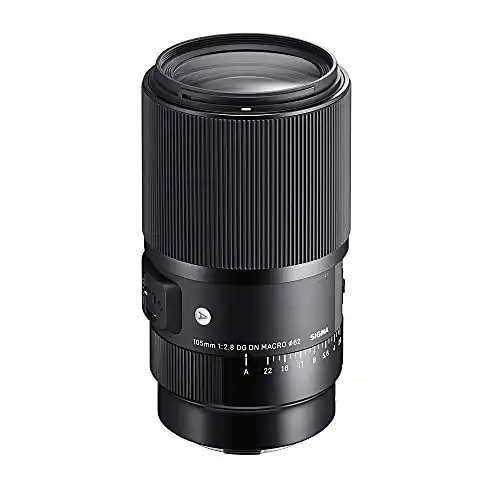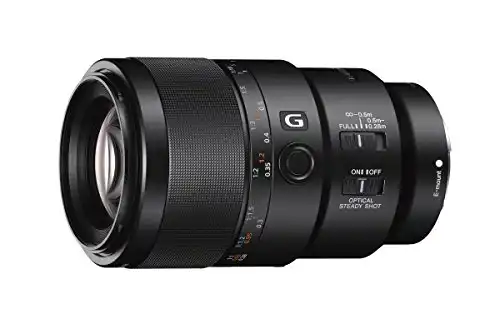Macro lenses are a popular choice for photographers who want to capture close-up details of small subjects, such as flowers, insects, jewelry, or food. In this article, we will compare Sigma 105mm f/2.8 DG DN Macro vs Sony FE 90mm f/2.8 Macro G OSS in detail and help you decide which one is best for your needs.
These two macro lenses typically have a 1:1 magnification ratio, meaning that the subject is reproduced at the same size on the sensor as it is in real life. They also have a shallow depth of field, creating a smooth background blur that isolates the subject from the surroundings.
Two of the most popular macro lenses for Sony E-mount cameras with full-frame or APS-C sensors are the Sigma 105mm f/2.8 DG DN Macro and the Sony FE 90mm f/2.8 Macro G OSS.
Both lenses offer a bright f/2.8 aperture, a fast and quiet autofocus system, and a high-quality optical design. But they also have some differences in terms of features, performance, and price.
Table of Contents
ToggleComparison: Sigma 105mm f/2.8 DG DN Macro vs Sony FE 90mm f/2.8 Macro G OSS
Build and Design
The Sigma 105mm f/2.8 DG DN Macro and the Sony FE 90mm f/2.8 Macro G OSS have similar dimensions and weight, but they differ in some aspects of their build and design.
The Sigma lens has a metal mount and a plastic barrel with a rubberized focus ring. It has a dust- and splash-proof construction and a fluorine coating on the front element to repel water and oil.
It also has an aperture ring with an A position lock switch and a focus limiter switch with three settings: full, 0.3-0.5m, and 0.5m-infinity. It does not have optical image stabilization (OIS), relying on the camera's in-body image stabilization (IBIS) instead.
The Sony lens has a metal mount and barrel with a smooth focus ring that can be pulled back to switch between autofocus and manual focus modes. It has a dust- and moisture-resistant design and a focus hold button that can be customized via the camera menu.
It has optical image stabilization (OIS) that works in conjunction with the camera's IBIS to provide up to 4.5 stops of compensation. It does not have an aperture ring or a focus limiter switch.
Best For: Professional and enthusiast photographers seeking exceptional image quality and versatility in macro and portrait photography with a Sony A6000.
- Excellent price point for the features offered
- Very sharp images with vibrant colors
- Short focusing distance ideal for close-up shots
- Autofocus limitations, manual focus may be preferred
| Feature | Sigma 105mm f/2.8 DG DN Macro | Sony FE 90mm f/2.8 Macro G OSS |
| Mount | Metal | Metal |
| Barrel | Plastic | Metal |
| Focus Ring | Rubberized | Smooth |
| Weather Sealing | Yes | Yes |
| Fluorine Coating | Yes | No |
| Aperture Ring | Yes | No |
| Focus Limiter Switch | Yes | No |
| Focus Hold Button | No | Yes |
| Optical Image Stabilization | No | Yes |
| Length | 133.6mm | 130.5mm |
| Diameter | 74mm | 79mm |
| Weight | 715g | 602g |
Performance
The Sigma 105mm f/2.8 DG DN Macro and the Sony FE 90mm f/2.8 Macro G OSS both deliver excellent performance in terms of image quality, autofocus, and bokeh.
The Sigma lens has 17 elements in 12 groups, including one SLD (Special Low Dispersion) element and one aspherical element to reduce chromatic aberrations and distortions. It also has a Super Multi-Layer Coating to minimize flare and ghosting. It has a rounded nine-blade diaphragm that creates smooth bokeh at wide apertures.
The Sony lens has 15 elements in 11 groups, including one ED (Extra-low Dispersion) glass element, one aspherical element, and one Super ED glass element to correct chromatic aberrations and distortions.
It also has a Nano AR Coating to suppress flare and ghosting. It has a rounded nine-blade diaphragm that produces pleasing bokeh at wide apertures.
These lenses both have a minimum focus distance of 0.3m (0.28m for the Sony lens) and a maximum magnification ratio of 1:1 at this distance. They both have an internal focusing mechanism that does not extend or rotate the front element during focusing, making them compatible with polarizing filters or macro accessories such as extension tubes or ring flashes.
They also both have a fast and quiet autofocus system that uses a stepping motor (RXD for the Sigma lens and DDSSM for the Sony lens) to drive the focusing group.
They both support eye AF and face detection and work well in low-light situations. They both have a manual focus override function that allows the user to adjust the focus manually by turning the focus ring, even when the lens is set to autofocus mode.
Both lenses produce sharp and detailed images across the frame, even at wide apertures. They both have a moderate amount of vignetting at f/2.8, which can be easily corrected in post-processing or by stopping down to f/4 or smaller.
They both have a low level of distortion, which is also easily corrected by software or by using the lens profile in the camera. They both have a good control of chromatic aberrations, with only some minor purple fringing in high-contrast areas that can be removed by software.
The Sigma 105mm f/2.8 DG DN Macro and the Sony FE 90mm f/2.8 Macro G OSS both create smooth and creamy bokeh at wide apertures, with circular out-of-focus highlights and a gradual transition from sharp to blurred areas. They both have a natural-looking rendering of colors and contrast, with a slightly warmer tone for the Sigma lens and a slightly cooler tone for the Sony lens.
Best For: Street photographers looking for exceptional image quality and versatile shooting capabilities.
- Nano AR Coating for reflection suppression
- Circular Aperture for enhanced bokeh effect
- Aspherical lens elements for reducing aberrations
- Heavy and bulky
| Feature | Sigma 105mm f/2.8 DG DN Macro | Sony FE 90mm f/2.8 Macro G OSS |
| Optical Formula | 17 elements in 12 groups | 15 elements in 11 groups |
| Special Elements | 1 SLD, 1 aspherical | 1 ED, 1 aspherical, 1 Super ED |
| Coating | Super Multi-Layer Coating | Nano AR Coating |
| Diaphragm Blades | 9 (rounded) | 9 (rounded) |
| Minimum Focus Distance | 0.3m | 0.28m |
| Maximum Magnification Ratio | 1:1 | 1:1 |
| Internal Focusing | Yes | Yes |
| Autofocus Motor | RXD (stepping motor) | DDSSM (stepping motor) |
| Manual Focus Override | Yes | Yes |
| Sharpness | Excellent | Excellent |
| Vignetting | Moderate at f/2.8, low at f/4 and smaller | Moderate at f/2.8, low at f/4 and smaller |
| Distortion | Low (barrel) | Low (barrel) |
| Chromatic Aberration | Low (purple fringing) | Low (purple fringing) |
| Bokeh | Smooth and creamy | Smooth and creamy |
| Color and Contrast | Natural and warm | Natural and cool |
Price
The Sigma 105mm f/2.8 DG DN Macro and the Sony FE 90mm f/2.8 Macro G OSS have a significant difference in price, with the Sigma lens being much cheaper than the Sony lens. However, both lenses can be found for lower prices online or during sales.
The Sigma lens offers a better value for money, as it delivers similar or better performance than the Sony lens in most aspects, except for optical image stabilization.
Conclusion
The Sigma 105mm f/2.8 DG DN Macro and the Sony FE 90mm f/2.8 Macro G OSS are both excellent macro lenses for Sony E-mount cameras, with superb image quality, fast and quiet autofocus, and smooth bokeh.
The Sigma lens has some advantages over the Sony lens, such as a longer focal length, an aperture ring, a focus limiter switch, a metal mount, a fluorine coating, and a lower price.
The Sony lens has some advantages over the Sigma lens, such as optical image stabilization, a focus hold button, a lighter weight, and a shorter minimum focus distance.
The choice between these two lenses depends on your personal preferences and needs. If you value optical image stabilization, especially for video or handheld shooting in low light, you might prefer the Sony lens. If you value a brighter aperture, especially for isolating your subject or creating more bokeh, you might prefer the Sigma lens.
Either way, you can't go wrong with either of these lenses, as they are both capable of producing stunning macro images.
Happy shooting!
Further Reading
(1) Sigma 105mm f/2.8 DG DN Macro vs Sony FE 90mm F2.8 Macro G OSS – Versus
(2) SIGMA 105mm vs SONY 90mm – Battle of the MACROS – YouTube
(3) Sigma 105mm F2.8 DG DN MACRO Art Review | Photography Blog
(4) Sony 90mm vs Sigma 105mm macro – Digital Photography Review


